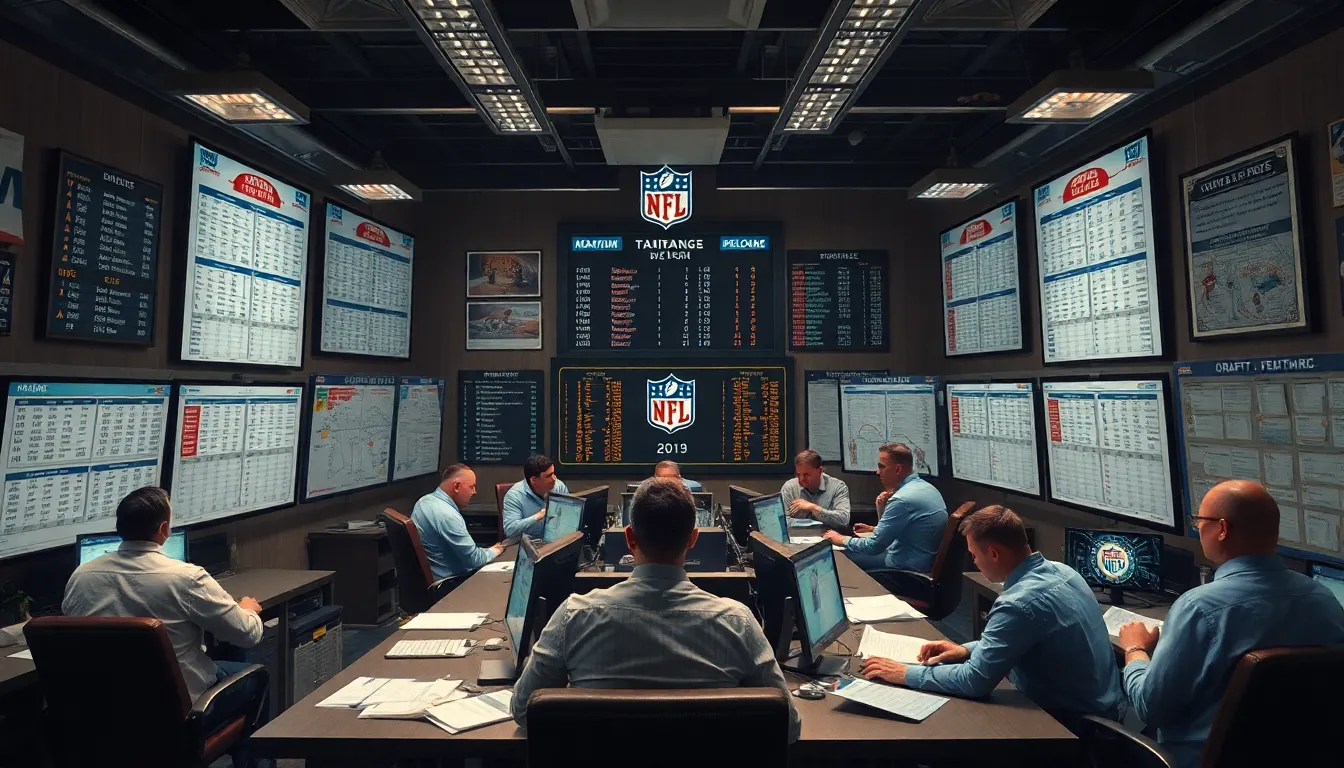As the NFL Draft approaches, anticipation builds like a kid waiting for the ice cream truck. The first round gets all the spotlight, but savvy fans know the real treasure often lies in the second round. This is where teams snag hidden gems who can turn the tide of a season faster than you can say “Super Bowl.”
Understanding the second round NFL draft order is crucial for fans and analysts alike. It’s not just about who’s picking next; it’s about the strategy, the potential trades, and the players who could become the next household names. So grab your favorite snack, settle in, and get ready to dive into the thrilling world of draft picks. Who knows? You might just discover the next superstar before they even step onto the field.
Table of Contents
ToggleOverview of the 2nd Round NFL Draft Order
The second round of the NFL Draft features 32 picks, providing each team with an opportunity to select emerging talent. Teams often strategize around this round, prioritizing positions where immediate impact can occur. Players available in the second round frequently include those who excelled in college but face questions that affect their draft stock.
Order of selection is crucial, as it can indicate a team’s approach for upcoming seasons. For example, a team with a high second-round pick might target a position of need or best player available. Each draft order can shift due to trades, adding excitement and unpredictability to the proceedings.
Round two selections may uncover hidden gems, making the draft process essential for fan engagement. The focus often shifts to positional needs, with cornerbacks, offensive linemen, and wide receivers frequently being sought after. Historical data shows that several Pro Bowl players emerged from this round, emphasizing its importance.
Analysis of mock drafts provides insights into what teams might prioritize. They highlight players expected to go in the early part as well as potential steals later in the round. Each team’s approach can vary based on their current roster needs, which shapes the overall draft order.
Understanding the current second round order improves fan engagement with the draft process. Fans can closely follow player selections, generating excitement as new talent joins NFL rosters. In the end, the second round represents a pivotal moment, reflecting each team’s strategy and vision for the future.
Factors Influencing the 2nd Round NFL Draft Order

Two key elements shape the 2nd round NFL Draft order: team needs and player rankings. Understanding these factors provides insight into how teams navigate the draft process.
Team Needs and Strategies
Every NFL team prioritizes its specific needs during the draft. Position requirements, roster gaps, and potential trades drive decisions. Winning teams often seek immediate impact players, while rebuilding franchises may focus on long-term potential. For instance, a team with an aging quarterback may target a young signal-caller to develop. Additionally, teams positioned early in the second round typically possess a broader strategy, balancing between filling critical roles and selecting the best talent available. This strategic planning ensures teams maximize their draft selections, enhancing their chances of success in upcoming seasons.
Player Rankings and Assessments
Player rankings significantly shape the 2nd round NFL Draft order. Evaluators analyze collegiate performance, physical attributes, and potential for growth. Prospects who excel in key positions—such as receiver or cornerback—often rank higher. Teams examine player assessments, including combine results and game tape, to gauge readiness for the NFL. Some players who excelled in college may slide in rankings due to concerns about their adaptability or character. This dynamic creates opportunities for teams to find hidden gems. Ultimately, informed decisions on player rankings and assessments greatly influence whom each team selects during this critical round.
Breakdowns of Team Picks
The second round of the NFL Draft presents opportunities for teams to enhance their rosters with strategic selections. Analyzing team picks reveals a mix of talent and strategy that can shape upcoming seasons.
Analysis of Top Picks
Top picks in the second round often reflect immediate team needs and player potential. Teams that pick early in the round frequently target offensive linemen, wide receivers, or linebackers to address gaps. Specific players may stand out due to their collegiate performance or combine results. For example, a standout wide receiver at a major college might get selected by a team needing a reliable target for their quarterback. Others, ranking high on teams’ boards, could include standout defensive players with proven records. Evaluators place emphasis on both skill sets and how well prospects can adapt to the pro game.
Potential Sleeper Picks
Sleeper picks in the second round often surprise fans and analysts alike. Certain players slide down draft boards despite impressive collegiate careers, creating hidden opportunities for savvy teams. A quarterback who experienced injuries or a running back limited by system fits can become valuable contributors. Teams that identify these prospects benefit from their potential upside at lower costs. Notable examples in previous drafts illustrate how unheralded players can emerge as stars. Locating these diamonds in the rough demands keen insight into player abilities and potential for growth in the professional landscape.
Predictions for the 2nd Round NFL Draft Order
The second round of the NFL Draft provides teams with a valuable opportunity to secure talented players. Teams may focus on specific positions based on their immediate needs while also considering overall potential. An analysis of team rankings reveals trends that can shape predictions.
Potential trades often influence the draft order, with teams looking to move up for coveted prospects. Evaluators emphasize the importance of collegiate performance, which can elevate certain players’ draft stock. Expect many teams to prioritize offensive linemen, wide receivers, and linebackers as they seek immediate contributors.
Ranked players with college success will likely grab attention during the second round. For example, defensive players with standout abilities may fall due to concerns related to adaptability. This opens the door for teams to find hidden talent.
Furthermore, sleeper picks often emerge, showcasing players whose collegiate performances exceed expectations. Organizations that identify these hidden gems can significantly improve their rosters. Historical examples of Pro Bowl players from prior second rounds highlight the critical nature of these selections.
Specific teams may target particular roles based on their overall strategies. Success in the upcoming season heavily depends on making informed decisions during the draft. Engaging with analysis of mock drafts provides further insight into team priorities and potential selections.
The second round of the NFL Draft serves as a crucial juncture for teams eager to bolster their rosters with impactful talent. Understanding the draft order and the strategies behind each selection can enhance fan engagement and provide deeper insights into team dynamics. As teams navigate their choices, the potential for discovering hidden gems remains high. The decisions made during this round can shape not just the immediate future but also the long-term success of franchises. With careful evaluation and strategic planning, the second round is where future stars can emerge, making it an exciting phase in the NFL Draft process.





